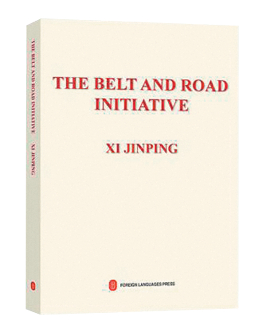
The Belt and Road Initiative
Author: Xi Jinping
Paperback, 308 pages
Published by Foreign Languages Press
This year marks the 10th anniversary of the Belt and Road Initiative (BRI). Marking this important milestone, the Third Belt and Road Forum for International Cooperation (BRF) was convened in Beijing last October. At its opening ceremony, Chinese President Xi Jinping delivered a keynote address titled “Building an Open, Inclusive and Interconnected World For Common Development.” Xi said, “The BRI, drawing inspiration from the ancient Silk Road and focusing on enhancing connectivity, aims to enhance policy, infrastructure, trade, financial and people-to-people connectivity, inject new impetus into the global economy, create new opportunities for global development, and build a new platform for international economic cooperation.”
Xi also summarized the great achievements that have been made over the past decade in his address. The Belt and Road cooperation has extended from the Eurasian continent to Africa and Latin America. More than 150 countries and over 30 international organizations have signed Belt and Road cooperation documents. So far, the initiative has progressed from “sketching the outline” to “filling in the details,” and blueprints have been turned into real projects. A large number of signature projects and “small yet smart” people-centered programs have been launched, he said.
The achievements made over the past 10 years are incredible, and the experience is worth summarizing. It has made the world realize that humanity is an interdependent community with a shared future. Only when the world is good can China be good; and when China is good, the world will be better.
To help foreign readers better understand Xi Jinping’s thoughts on the BRI and promote international cooperation, The Belt and Road Initiative was jointly compiled by the Research Institute of Party History and Literature of the CPC Central Committee and the Office of the Leading Group for the BRI. The book contains more than 40 speeches and excerpts on the BRI delivered by Xi between September 2013 and July 2018, recording the whole process of Xi’s proposal on the BRI, and the effort he has made to enrich and develop the initiative.
The BRI, proposed by Xi in 2013, has been well received by the international community, especially from the BRI participating countries. As one of China’s key measures in pursuing all-round opening-up in the new era, the BRI serves as an important platform for building a global community with a shared future for humanity, providing the world with solutions for common prosperity and development. Expounding on the guiding principles, rich content, goals, and methods behind the initiative, Xi has pointed out the direction for common development of the world, and mapped out a bright future for China.
The book starts from a speech given by Xi at Nazarbayev University in Kazakhstan in September 2013. More than 2,100 years ago, a Chinese envoy named Zhang Qian of the Han Dynasty (206 BC-AD 220), began developing friendly contacts between China and Central Asian countries, which helped usher in the Silk Road linking the East and the West. Xi evoked familiar memories as he mentioned the sounds of camel bells echoing in the mountains and the wisps of smoke rising from the desert. While telling the historical stories of people-to-people exchanges, a blueprint with Chinese wisdom for common prosperity and development was presented to the world: “To forge closer economic ties, deepen cooperation and expand development space in the Eurasian region, we should take an innovative approach and jointly build an economic belt along the Silk Road,” said Xi, marking the first time that the idea of the Silk Road Economic Belt was put forward.
In June 2014, the Sixth Ministerial Conference of the China-Arab States Cooperation Forum was held in Beijing. On that occasion, Xi formally used the term “the Belt and Road” for the first time, and systematically expounded on the spirit of the Silk Road and the principles that should be adhered to in the construction of the BRI. He stated that, “The Belt and Road, namely the Silk Road Economic Belt and the Maritime Silk Road of the 21st Century, represent paths towards mutual benefit which will bring about closer economic integration among the countries involved, promote development of their infrastructure and institutional innovation, create new economic and employment growth areas, and enhance their capacity to achieve endogenous growth and to protect themselves against risks.”
In November 2014, at the eighth meeting of the Leading Group for Financial and Economic Affairs under the CPC Central Committee, Xi stressed the need to concentrate on this initiative, design an overall strategy for the initiative, and prepare timetables and road maps for the coming years as soon as possible, while also identifying areas of opportunity ripe for an early harvest.
After the BRI was put forward, Xi took advantage of various occasions and opportunities to have candid and in-depth dialogues and communication with all parties concerned, trying to enhance strategic mutual trust, dispel misunderstanding, and forge broad consensus.
In 2016, as part of the initiative’s success, the Asian Infrastructure Investment Bank was established. In 2017, the first BRF was held in China, with guests from more than 130 countries gathered in Beijing to discuss the construction and cooperation of the BRI. Then in 2019, the second such forum was held in Beijing with representatives from over 150 countries and 92 international organizations, who reached extensive consensus on promoting high-quality Belt and Road cooperation, and achieved fruitful outcomes.
This book has profoundly elucidated the significance of the BRI, from such perspectives as expanding opening-up, promoting common development and prosperity, and promoting the building of a community with a shared future for humankind. It has also provided new ideas and plans for improving the global economic governance system, contributing China’s wisdom to the world.